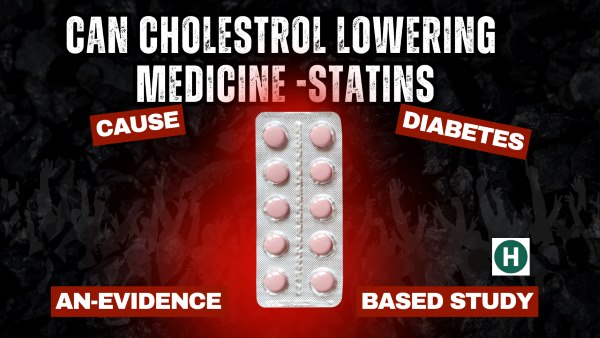Statins, the gold-standard medications for lowering low-density lipoprotein cholesterol (LDL-C), are prescribed to millions worldwide to prevent cardiovascular diseases (CVD), the leading cause of death in India and globally. With approximately 74 million diabetic patients in India and an estimated rise to 93 million by 2030, concerns about statin-induced diabetes have sparked debate. In 2012, the U.S. Food and Drug Administration (FDA) issued a warning about statins potentially increasing blood sugar levels and diabetes risk, prompting scrutiny in India, where 25–30% of urban and 15–20% of rural populations have dyslipidemia. This article titled – Can Cholesterol-Lowering Medicine Statins Cause Diabetes? An Evidence-Based Analysis co-authored by Deepti Verma and Shahid Ali Khan examines evidence from clinical trials, meta-analyses, and mechanistic studies to determine whether statins cause diabetes in the long run, their clinical implications, and how patients and clinicians can balance cardiovascular benefits with diabetes risks.
Keywords: statins, diabetes, cholesterol, new-onset diabetes, cardiovascular disease, India, HMG-CoA reductase, insulin resistance
Understanding Statins the Cholesterol-Lowering Medicine and Their Role
Statins (e.g., atorvastatin, rosuvastatin, simvastatin) inhibit 3-hydroxy-3-methylglutaryl-coenzyme A (HMG-CoA) reductase, a key enzyme in cholesterol synthesis, reducing LDL-C by 30–60% depending on dose and type. They are prescribed for primary and secondary prevention of CVD, reducing the risk of heart attack and stroke by approximately 25% per 1 mmol/L LDL-C reduction. In India, where CVD accounts for 27% of deaths, statins are critical for managing dyslipidemia, especially in high-risk groups like those with diabetes or metabolic syndrome.
However, the 2012 FDA warning highlighted a potential link between statins and increased hemoglobin A1c (HbA1c) and fasting glucose levels, raising concerns about new-onset diabetes (NOD). This is particularly relevant in India, where diabetes prevalence is high, and lifestyle factors like obesity and sedentary habits amplify risks. This article synthesizes evidence to address whether statins cause diabetes long-term, their mechanisms, and clinical implications for Indian patients.
Can Statins Cause Diabetes? Evidence from Clinical Trials and Meta-Analyses
1. Clinical Trials on Statin Use and Diabetes Risk
Multiple randomized controlled trials (RCTs) and meta-analyses have investigated the association between statins and NOD:
JUPITER Trial (2008): The Justification for the Use of Statins in Prevention: an Intervention Trial Evaluating Rosuvastatin (JUPITER) with 17,802 participants found a 27% increased risk of diabetes in the rosuvastatin group compared to placebo over two years, with an absolute risk increase of 0.6%. This trial sparked initial concerns about statin-induced diabetes.
CTT Collaboration Meta-Analysis (2010): A meta-analysis of 13 RCTs with 91,140 participants showed a 9% increased risk of NOD with statins (odds ratio [OR] 1.09, 95% CI 1.02–1.17), translating to one additional diabetes case per 1,000 person-years. The risk was higher with high-intensity statins.
CTT Collaboration (2024): A more recent analysis of 19 RCTs with 123,940 participants confirmed a dose-dependent increase in NOD, with a 10% higher risk for low/moderate-intensity statins and 24% for high-intensity statins. The mean increase in blood glucose was small, primarily affecting those with pre-existing risk factors like prediabetes.
LODESTAR Trial (2023): Comparing rosuvastatin and atorvastatin in 4,400 patients with coronary artery disease, rosuvastatin showed a higher diabetes risk (7.2% vs. 5.3%) over three years, despite similar CVD benefits.
2. Observational Studies
Observational studies, while less robust than RCTs, provide real-world insights:
Zigmont et al. (2019): A study of 4,683 U.S. patients found statin users had double the risk of NOD compared to non-users, with a three-fold risk for those using statins for over two years. This suggests a dose-duration relationship.
Indian Context: A 2022 scoping review noted that India’s high diabetes burden (74 million) amplifies concerns about statin-induced diabetes, particularly in urban populations with dyslipidemia.
3. Key Findings
Risk Magnitude: Statins increase NOD risk by 9–27%, with high-intensity statins (e.g., atorvastatin 80 mg, rosuvastatin 20 mg) posing a higher risk (20–24%) than moderate-intensity statins (11%).
Absolute Risk: The absolute risk is low, with 1–2 additional diabetes cases per 100–200 statin users over five years.
Population at Risk: The risk is largely confined to individuals with pre-existing risk factors, such as prediabetes, obesity, high triglycerides, or metabolic syndrome.
Mechanisms of Statin-Induced Diabetes
Statins may contribute to NOD through several mechanisms, primarily affecting insulin resistance and secretion:
HMG-CoA Reductase Inhibition: Statins block the mevalonate pathway, reducing cholesterol synthesis and downstream metabolites like isoprenoids, which regulate insulin signaling. This increases insulin resistance and impairs glucose metabolism.
LDL Receptor Upregulation: Reduced cholesterol synthesis upregulates LDL receptors (LDLR), increasing cholesterol uptake in pancreatic β-cells, disrupting glucose-induced Ca2+ signaling, and reducing insulin secretion.
Insulin Resistance: A 2021 trial of atorvastatin 40 mg in 71 adults showed an 8% increase in insulin resistance (measured by steady-state plasma glucose) and a 9% increase in insulin secretion, suggesting compensatory mechanisms that may fail long-term in predisposed individuals.
Lipophilicity: Lipophilic statins (e.g., simvastatin, atorvastatin) inhibit L-type Ca2+ channels in β-cells, reducing insulin secretion more than hydrophilic statins (e.g., pravastatin, rosuvastatin).
Genetic Factors: Variants in the HMGCR gene (e.g., rs17238484-G) are associated with a 2–6% higher diabetes risk, alongside weight gain and higher glucose levels.
These mechanisms suggest that statins may accelerate diabetes onset in at-risk individuals by pushing blood glucose levels over the diagnostic threshold.
Can Statins Cause Diabetes in Indians: Clinical Implications for Indian Patients
1. Risk-Benefit Analysis
Cardiovascular Benefits: Statins reduce CVD events by 21–25% per 1 mmol/L LDL-C reduction, significantly outweighing the diabetes risk in high-risk patients (e.g., those with prior CVD or diabetes).
Low Absolute Risk: The small absolute risk (0.2% per year) means 10-fold greater CVD benefits compared to diabetes risk.
Indian Context: With India’s high CVD burden (27% of deaths) and diabetes prevalence, statins remain crucial for primary and secondary prevention, especially in urban populations with dyslipidemia.
2. Vulnerable Populations
Prediabetes: Patients with fasting glucose or HbA1c near the diabetes threshold are at higher risk of NOD.
Elderly and Women: Women and older adults show a higher propensity for statin-induced diabetes, possibly due to metabolic differences.
Obesity and Metabolic Syndrome: High triglycerides and central obesity amplify diabetes risk in statin users.
3. Monitoring and Management
Glucose Monitoring: Clinicians should monitor HbA1c or fasting glucose post-statin initiation, though no evidence-based frequency exists.
Lifestyle Interventions: Diet, exercise, and weight loss can nullify diabetes risk while enhancing CVD protection.
Statin Choice: Hydrophilic statins (e.g., pravastatin) may have a lower diabetogenic effect than lipophilic statins.
Addressing Common Concerns (FAQs) on Can Cholesterol-Lowering Medicine Statins Cause Diabetes?
Do statins cause diabetes long-term? Statins increase NOD risk by 9–27%, primarily in predisposed individuals, with a small absolute risk (1–2 cases per 100–200 users).
Which statins are riskier for diabetes? High-intensity statins (e.g., rosuvastatin 20 mg, atorvastatin 80 mg) pose a higher risk (20–24%) than moderate-intensity statins (11%).
Can lifestyle changes reduce statin-related diabetes risk? Yes, modest lifestyle improvements (diet, exercise) can offset diabetes risk and enhance CVD benefits.
Should Indian patients avoid statins due to diabetes risk? No, the CVD benefits outweigh the small diabetes risk, especially for high-risk patients. Consult your doctor for personalized advice.
Critical Evaluation
Strengths of Statins
Proven Efficacy: Statins reduce CVD events and mortality by 25%, making them indispensable for high-risk patients.
Tolerability: Adverse effects are mild and transient in most cases, with only 3–4% of patients discontinuing due to side effects.
Limitations and Risks
- Small but Real Risk: The 9–27% relative risk increase translates to a low absolute risk, but it’s significant for India’s large diabetic population.
- Mechanistic Uncertainty: The exact pathways (e.g., β-cell dysfunction vs. insulin resistance) remain unclear, requiring further research.
- Media Hype: Sensationalized reports (e.g., “Statins double diabetes risk”) exaggerate risks, causing patient anxiety and non-adherence.
Indian Context
India’s dual burden of CVD and diabetes necessitates cautious statin use. Urban populations with high dyslipidemia rates (25–30%) and rural populations (15–20%) require tailored monitoring, especially given the genetic and lifestyle predispositions to diabetes.
Conclusion
Evidence confirms that statins, while critical for CVD prevention, carry a modest, dose-dependent risk of new-onset diabetes, particularly in individuals with prediabetes, obesity, or metabolic syndrome. The relative risk ranges from 9–27%, but the absolute risk is low (0.2% per year), and cardiovascular benefits significantly outweigh this risk for most patients. In India, where CVD and diabetes are major health challenges, statins remain a cornerstone of therapy. Clinicians should monitor glucose levels, prioritize lifestyle interventions, and consider hydrophilic statins for at-risk patients to optimize outcomes. Patients should discuss individual risks with their healthcare providers to make informed decisions.
What do you think – should statins be avoided due to diabetes risk, or are the heart benefits worth it? Share your thoughts!
References
- Johns Hopkins Medicine. (2024). 3 Myths About Cholesterol-Lowering Statin Drugs.
- Cleveland Clinic Journal of Medicine. (2023). Statins may increase diabetes, but benefit still outweighs risk.
- The Lancet Diabetes & Endocrinology. (2024). Effects of statin therapy on diagnoses of new-onset diabetes and worsening glycaemia.
- PubMed. (2015). Statins and diabetes risk: how real is it and what are the mechanisms?
- CDC. (2024). Statins and Diabetes: What You Should Know.
- Endocrine News. (2020). Statins and Diabetes: How Big Is the Risk?
- PMC. (2023). Statins and risk of type 2 diabetes: mechanism and clinical implications.
- Diabetes Spectrum. (2013). The Role of Statins in Diabetes Treatment.
- PMC. (2020). Statin Treatment-Induced Development of Type 2 Diabetes: From Clinical Evidence to Mechanistic Insights.
- Arteriosclerosis, Thrombosis, and Vascular Biology. (2021). Statin-Related New-Onset Diabetes Appears Driven by Increased Insulin Resistance.
- PMC. (n.d.). Statin induced diabetes and its clinical implications.
- Arteriosclerosis, Thrombosis, and Vascular Biology. (2021). Statins Are Associated With Increased Insulin Resistance and Secretion.
- Mayo Clinic. (2024). Statins: Are these cholesterol-lowering drugs right for you?
- The BMJ. (2023). Risk of diabetes with statins.
- Nuffield Department of Population Health. (2024). Statins can cause a small increase in blood sugar levels.
- ScienceDirect. (2023). Statins and diabetes: What are the connections?
- PMC. (n.d.). Statin induced diabetes and its clinical implications.
- MDPI. (2022). A Scoping Review on the Reported Evidence and Gaps of the Risk of Diabetes in Dyslipidemic Patients under Statin Therapy.
- The BMJ. (2023). New study sheds light on long term effectiveness and safety of two widely used statins.
- Diabetes UK. (2021). Statins and Diabetes – Uses and Side Effects.
- PMC. (2023). Statins and risk of type 2 diabetes: mechanism and clinical implications.
- PMC. (2020). Statin Treatment-Induced Development of Type 2 Diabetes: From Clinical Evidence to Mechanistic Insights.
- PMC. (2016). Do statins really cause diabetes?: A meta-analysis of major randomized controlled clinical trials.
- ScienceDaily. (2019). Cholesterol medication could invite diabetes, study suggests.
Authorship Note: This article was co-authored by Deepti Verma and Shahid Ali Khan through rigorous research and evidence-based analysis. While not doctors, they have meticulously reviewed clinical trials, meta-analyses, and expert insights to provide accurate information for HealthViews India readers. For personalized medical advice, consult a qualified healthcare provider.




